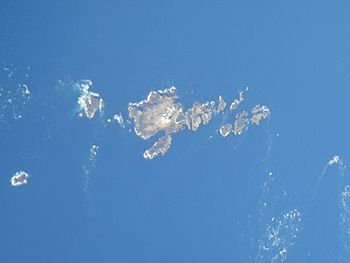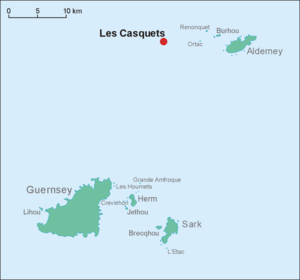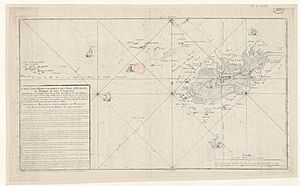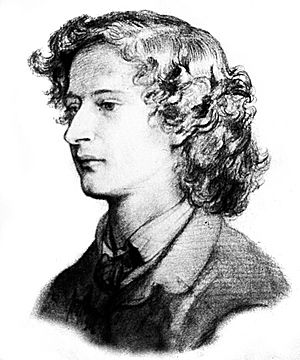Les Casquets facts for kids

Aerial view of Les Casquets
|
|
| Geography | |
|---|---|
| Location | English Channel, northwest of Alderney |
| Coordinates | 49°43′19″N 2°22′37″W / 49.72194°N 2.37694°W |
| Administration | |
| Demographics | |
| Population | 0 (2007) |
Les Casquets are a group of rocky islets located about 13 kilometers (8 miles) northwest of Alderney. Alderney is one of the Channel Islands, which are part of the Bailiwick of Guernsey. These rocks are actually the tops of an underwater sandstone ridge. Other parts of this ridge that stick out of the water include the islets of Burhou and Ortac. Not much plant life grows on Les Casquets because they are mostly just rocks.
Contents
What's in a Name?
People have different ideas about where the name "Casquets" came from. Here are a few theories:
- Some think it comes from the French word "cascade," which means a small waterfall. This might refer to the strong tides and water surges that rush around the rocks.
- Another idea is that it comes from "casque," which is a type of helmet. The rocks might have looked like helmets to early sailors.
- A third theory suggests it comes from two French words: "cas" (meaning broken) and "quet" (meaning rock). So, "broken rocks."
An old map from around 1640 called them Casus Rupes, which means "broken rocks" in Latin. This seems to support the third idea, but it might just be a folk story about the name's origin.
History of Les Casquets
Shipwrecks and Strong Tides
Many ships have crashed on the Casquets rocks over the years. This happened because of the very strong tides in the area, which can reach speeds of 6–7 knots during spring tides. Also, there weren't many clear landmarks to guide ships away from the dangers.
One of the most famous shipwrecks was the SS Stella in 1899. Sadly, 105 people lost their lives in that accident. The biggest ship to wreck there was the 8,000-tonne water tanker Constantia S, which was lost in 1967.
For a long time, people believed that HMS Victory sank near the Casquets in 1744. The lighthouse keeper on Alderney was even put on trial for supposedly not keeping the light on that night! However, when the wreck of HMS Victory was found in 2008, it was actually over 110 kilometers (60 nautical miles) away from the Casquets.
World War II Raid
During World War II, the Casquets were the site of a brave raid by a British commando unit. This happened on September 2, 1942. The raid was led by Major Gus March-Phillipps and was one of the first missions for Anders Lassen, who later became a very famous commando. During the raid, the British soldiers captured all seven German soldiers stationed on the island. They took them back to England as prisoners and also destroyed the radio and lighthouse equipment.
Les Casquets in Books
Swinburne's Poem
The poet A. C. Swinburne wrote a poem called Les Casquets. It tells the story of the Houguez family, who actually lived on the island for 18 years. They were originally from Alderney. The poem describes their life on the lonely rocks. Their daughter falls in love with a carpenter from Alderney and moves to his island. But she finds life there too busy. The "small bright streets of serene St Anne" and "the sight of the works of men" were too much for her, so she returned to the quiet life on Les Casquets.
Victor Hugo's The Laughing Man
Victor Hugo, a famous French writer, lived on Guernsey and wrote a lot about the Channel Islands. In his novel The Laughing Man (published in 1869), he describes the dangers of the Casquets:
To be wrecked on the Casquets is to be cut into ribbons; to strike on the Ortac is to be crushed into powder... On a straight frontage, such of that of the Ortac, neither the wave nor the cannon ball can ricochet... if the wave carries the vessel on the rock she breaks on it, and is lost...
This quote shows how dangerous the rocks were for ships.
C. S. Forester's Hornblower and the Hotspur
In the book Hornblower and the Hotspur by C. S. Forester, the main character, Horatio Hornblower, is sent to explore the port of Brest before a war with France begins. The Casquets are mentioned as a place that ships need to be very careful around when sailing in that area.
Images for kids
See also
 In Spanish: Casquets para niños
In Spanish: Casquets para niños
- Casquets lighthouses






